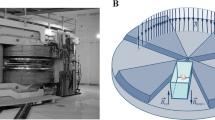Summary
Transplantation of bone marrow cells of magnetic-field-exposed mice led to increased numbers of spleen colonies (CFU-S 7d) in conditioned recipient mice (Peterson et al. 1986). Here we report on the dependence of this phenomenon on body temperature, field strength and exposure time. It was found that the effect can only be seen when the body temperature is 27° C, the field strength not less than 1.4 T and the exposure time at least 15 min. It is suggested that the magnetic field increases the number of spleen colonies either directly by affecting membrane components (receptors) responsible for the seeding of the transplanted stem cells to the recipient spleens or indirectly affecting radical/redox-systems that may have a regulatory function in the stem cells.
Similar content being viewed by others
References
Aceto H Jr, Tobias CA, Silver IL (1970) Some studies on the biological effects of magnetic fields. IEEE Trans Mag 6:368–373
Braganza LF, Blott BH, Coe TJ, Melville D (1984) The superdiamagnetic effect of magnetic fields on one and two component multilamellar liposomes. Biochem Biophys Acta 801:66–75
Chiles C, Hawrot E, Gore J, Byck R (1989) Magnetic field modulation of receptor binding. Magn Res Med 10:241–245
Feinendegen LE, Mühlensiepen H (1985) Magnetic field affects thymidine kinase in vivo. Int J Radiat Biol 47:723–730
Feinendegen LE, Mühlensiepen H (1987) In vivo enzyme control through a strong stationary magnetic field - the case of thymidine kinase in mouse bone marrow cells. Int J Radiat Biol 52:469–479
Hardy CL, Kishimoto T, Harjes K, Tavassoli M, Greenberger JS (1986) Homing of a cloned multipotential stem cell line in spleen and intraperitoneal membrane. Exp Hematol 14:636–642
Liburdy RP, Tenforde TS (1986) Magnetic field-induced drug permeability in liposome vesicles. Radiat Res 108:102–111
Lord BI, Murphy MJ Jr (1985) Hypoxia - Experimental results: The response of hemopoietic stem cells to hypoxia. In: Wichmann H-E, Loeffler M (eds) Mathematical modeling of cell proliferation: stem cell regulation in hemopoiesis, vol I. CRC Press, Boca Raton, Florida, pp 193–204
Lorimore SA, Kowalczuk CI, Saunders RD, Wright EG (1990) Lack of acute effects of 20 mT, 50 Hz magnetic fields on murine haemopoiesis. Int J Radiat Biol 58:713–723
Maret G, Dransfeld V (1985) Magnetic fields. In: Herlach F (ed) Topics in Applied Physics, vol 57. Springer, Berlin Heidelberg New York, pp 143–204
Monette FC, Demello JB (1979) The relationship between stem cell seeding efficiency and position in cell cycle. Cell Tissue Kinet 12:161–175
Papatheofanis FJ (1990) Use of calcium channel antagonists as magnetoprotective agents. Radiat Res 122:24–28
Pereira MR, Nutini LG, Fardon JC, Cook ES (1967) Cellular respiration in intermittent magnetic fields. Proc Soc Exp Biol Med 124:573–576
Peterson H-P, Mühlensiepen M, Wangenheim K-H v, Feinendegen LE (1986) Blood forming stem cells. Reactions to low dose irradiation, vitamin E deficiency and magnetic field. Naturwissenschaften 73:623–625
Peterson H-P, Wangenheim K-H v, Feinendegen LE (1989) Early and late effects in the bone marrow of mice following 2 Gy (MeV) neutron irradiation. Radiat Environ Biophys 28:291–302
Tenforde TS, Gaffey CT, Moyer BR, Budinger TF (1983) Cardiovascular alterations in Macaca monkeys exposed to stationary magnetic fields: experimental observations and theoretical analysis. Bioelectromagnetics 4:1–9
Tenforde TS, Liburdy RP (1988) Magnetic deformation of phospholipid bilayers: Effects on liposome shape and solute permeability at prephase transition temperatures. J Theor Biol 133:385–396
Till JE, McCulloch EA (1961) A direct mesurement of the radiation sensitivity of normal mouse bone marrow cells. Radiat Res 14:213–222
Ueda I, Kamaya H (1984) Molecular mechanisms of anesthetics. Anesth Analg 63:929–945
Viktora L, Fiala J, Petz R (1976) Effect of prolonged exposure to a magnetic field on the haematopoietic stem cell. Physiol Bohemoslov 25:359–364
Author information
Authors and Affiliations
Rights and permissions
About this article
Cite this article
Peterson, H.P., von Wangenheim, K.H. & Feinendegen, L.E. Magnetic field exposure of marrow donor mice can increase the number of spleen colonies (CFU-S 7d) in marrow recipient mice. Radiat Environ Biophys 31, 31–38 (1992). https://doi.org/10.1007/BF01211510
Received:
Accepted:
Issue Date:
DOI: https://doi.org/10.1007/BF01211510




